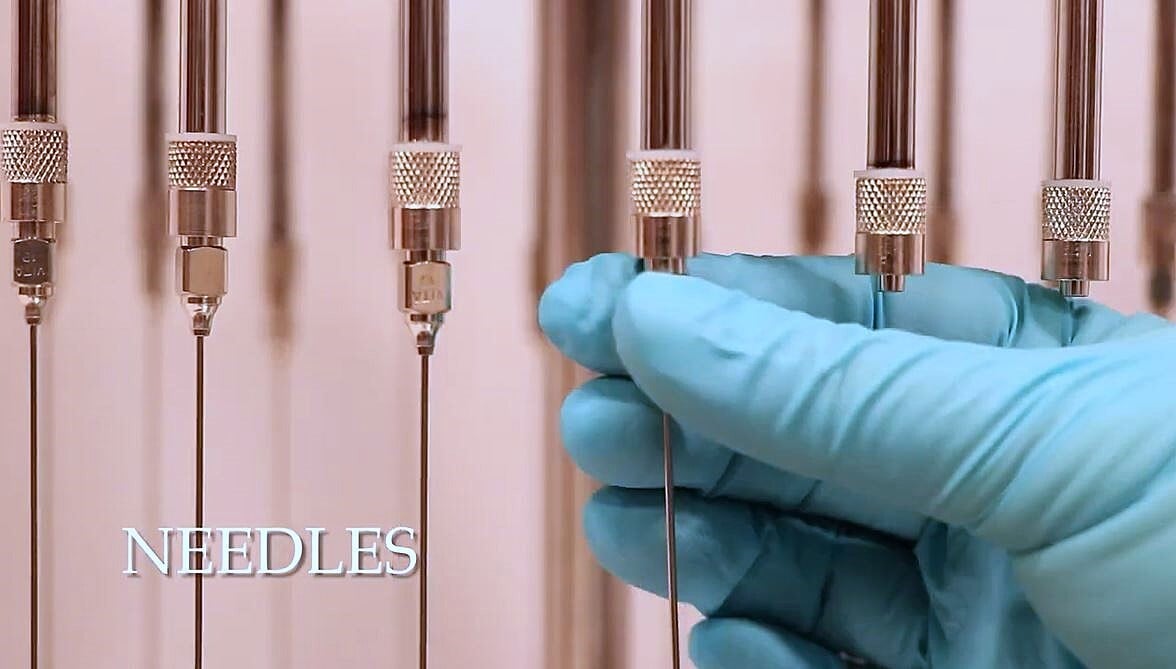
Evaporation needles take the brunt of exposure to solvent vapor during the evaporation process. You may notice solvent droplets forming on the tips of the needles during evaporation. While this is normal, needles should be washed and dried after each use to prevent clogs or corrosion and to reduce the risk of contamination between sample batches.
Needles can be cleaned by hand, with an autoclave, or with an ultrasonic cleaner depending on what is available in the lab and the types of contamination that are of concern.
1. Manual cleaning:
For removing solvent residue and most contaminants
Manual cleaning will remove solvent residue along with most contaminants. This can be followed by autoclaving if biological contamination between samples is of specific concern.
→ Manual cleaning instructions (suitable for both stainless steel and Teflon-coated needles)
1. Remove all evaporation needles from the evaporator by twisting each in a clockwise direction. Caution: wearing gloves and eye protection is recommended to prevent exposure to potentially harmful substances on the needle surface.
2. Wet a soft cloth or laboratory wipe with acetone, ethanol, or THF.
3. Wipe the entire exterior surface of each needle to remove all residues and oils. This is best accomplished by folding the cloth or wipe in half and placing the needle body between the layers. Apply pressure to the needle body with the thumb and index finger while simultaneously rotating and pulling the needle through the folded cloth or wipe with the other hand. Repeat if necessary to remove all external soils and residues.
4. Fill a 150 mL beaker or similar about halfway with a gentle cleaning solution such as Liquinox.
5. Mount a needle on a 10-20 mL syringe and immerse the tip of the needle in the cleaning solution. Slowly withdraw the syringe plunger to draw the cleaning solution through the needle and into the syringe barrel. When the barrel is about half full, depress the plunger to return the cleaning solution back to the beaker. Repeat this procedure 3-4 times with each needle before discarding the used cleaning solution.
6. Rinse the beaker, syringe, and exterior surface of each needle with deionized water to remove the cleaning solution and any suspended solids.
7. the beaker approximately halfway with deionized water and repeat step 5 to rinse the inside of each needle 3-4 times.
8. Dry the needles for 6-8 hours in a laboratory drying oven at 105-110 °C, or alternatively rinse the needles with acetone, ethanol, or THF, drain, and dry in a laboratory drying oven at 105-110 °C for 2-3 hours.
9. Cleaned needles can be reinstalled on the evaporator or stored for future usage.
2. Ultrasonic cleaner:
For removing both solvent residue and biological contaminants
An ultrasonic cleaner will remove solvent residue, and some models can also sterilize the needles. If the ultrasonic cleaner uses a detergent or non-volatile cleaning solvent, needles will need to be rinsed afterwards using DI water to remove residue from the cleaner.
3. Autoclave:
For removing biological contaminants only
Autoclaving kills biological contaminants such as bacteria and viruses, but may not remove all solvent residue. It is useful when the main concern is preventing microbial contamination between samples. To protect against needle corrosion when evaporating acids or other corrosive solvents, we would recommend pre-cleaning with one of the other cleaning methods first.
Labs opting to use an autoclave or ultrasonic cleaner should follow manufacturer recommendations regarding parameters like time and temperature.
Organomation’s evaporation needles are meant to be semi-consumable, and replacement is recommended every 1-2 years depending on usage and care. Needles that are slightly bent can often be bent back into shape by hand. Needles that are blocked, corroded, or severely bent should be replaced to ensure consistent evaporation.
If you notice significant corrosion, consider switching to Teflon-coated needles (Cat# NA0603-T) for additional protection against steam and solvent vapor. Learn more on when you should consider switching to Teflon needles.
Visit our online store to purchase a set of Teflon-coated needles.
